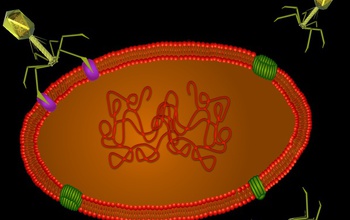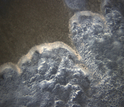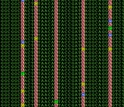News Release 15-024
The 'intraterrestrials': New viruses discovered in ocean depths
Viruses infect methane-eating archaea beneath the seafloor

Graphic of viruses attempting to "dock" on a microbial mat, using the tips of their tails.
March 23, 2015
This material is available primarily for archival purposes. Telephone numbers or other contact information may be out of date; please see current contact information at media contacts.
The intraterrestrials, they might be called.
Strange creatures live in the deep sea, but few are odder than the viruses that inhabit deep ocean methane seeps and prey on single-celled microorganisms called archaea.
The least understood of life's three primary domains, archaea thrive in the most extreme environments on the planet: near hot ocean rift vents, in acid mine drainage, in the saltiest of evaporation ponds and in petroleum deposits deep underground.
Virus in the deep blue sea
While searching the ocean's depths for evidence of viruses, scientists have found a remarkable new one, a virus that seemingly infects archaea that live beneath the ocean floor.
The researchers were surprised to discover that the virus selectively targets one of its own genes for mutation, and that this capacity is also shared by archaea themselves.
The findings appear today in a paper in the journal Nature Communications.
The project was supported by a National Science Foundation (NSF) Dimensions of Biodiversity grant to characterize microbial diversity in methane seep ecosystems. Dimensions of Biodiversity is supported by NSF's Directorates for Biological Sciences and Geosciences.
New information about life in ocean depths
"Life far beneath the Earth's subsurface is an enigma," said Matt Kane, program director in NSF's Division of Environmental Biology. "By probing deep into our planet, these scientists have discovered new information about Earth's microbes and how they evolve."
"Our study uncovers mechanisms by which viruses and archaea can adapt in this hostile environment," said David Valentine, a geoscientist at the University of California Santa Barbara (UCSB) and co-author of the paper.
The results, he said, raise new questions about the evolution and interaction of the microbes that call the planet's interior home.
"It's now thought that there's more biomass inside the Earth than anywhere else, just living very slowly in this dark, energy-limited environment," said paper co-author Sarah Bagby of UCSB.
Using the submersible Alvin, Valentine and colleagues collected samples from a deep-ocean methane seep by pushing tubes into the ocean floor and retrieving sediments.
The contents were brought back to the lab and fed methane gas, helping the methane-eating archaea in the samples to grow.
When the team assayed the samples for viral infection, they discovered a new virus with a distinctive genetic fingerprint that suggested its likely host was methane-eating archaea.
Genetic sequence of new virus holds the key
The researchers used the genetic sequence of the new virus to chart other occurrences in global databases.
"We found a partial genetic match from methane seeps off Norway and California," said lead author Blair Paul of UCSB. "The evidence suggests that this viral type is distributed around the globe in deep ocean methane seeps."
Further investigation revealed another unexpected finding: a small genetic element, known as a diversity-generating retroelement, that accelerates mutation of a specific section of the virus's genome.
Such elements had been previously identified in bacteria and their viruses, but never among archaea or the viruses that infect them.
"These researchers have shown that cutting-edge genomic approaches can help us understand how microbes function in remote and poorly known environments such as ocean depths," said David Garrison, program director in NSF's Division of Ocean Sciences.
While the self-guided mutation element in the archaea virus resembles known bacterial elements, the researchers found that it has a divergent evolutionary history.
"The target of guided mutation--the tips of the virus that make first contact when infecting a cell--is similar," said Paul.
"But the ability to mutate those tips is an offensive countermeasure against the cell's defenses, a move that resembles a molecular arms race."
Unusual genetic adaptations
Having found guided mutation in a virus-infecting archaea, the scientists reasoned that archaea themselves might use the same mechanism for genetic adaptation.
In an exhaustive search, they identified parallel features in the genomes of a subterranean group of archaea known as nanoarchaea.
Unlike the deep-ocean virus that uses guided mutation to alter a single gene, the nanoarchaea target at least four distinct genes.
"It's a new record," said Bagby.
"Bacteria had been observed to target two genes with this mechanism. That may not seem like a huge difference, but targeting four is extraordinary."
According to Valentine, the genetic mutation that fosters these potential variations may be key to the survival of archaea beneath the Earth's surface.
"The cell is choosing to modify certain proteins," he said. "It's doing its own protein engineering. While we don't yet know what those proteins are being used for, learning about the process can tell us something about the environment in which these organisms thrive."
Viral DNA sequencing was provided through a Gordon and Betty Moore Foundation grant. The research team also included scientists from the University of California, Los Angeles; the University of California, San Diego; and the U.S. Department of Energy's Joint Genome Institute.
-NSF-
-
Scientist Blair Paul prepares a sediment core for further sampling on the research vessel Atlantis.
Credit and Larger Version -
The scientists used the deep submergence vehicle Alvin to retrieve sea-floor samples.
Credit and Larger Version -
Image of the sea floor at the methane seep investigated, taken with the underwater vehicle Sentry.
Credit and Larger Version -
Near the sampling location, a carbonate ridge is home to microbial mats and chemosynthetic clams.
Credit and Larger Version -
Multiple DNA sequences are aligned to highlight the patterns observed in the study.
Credit and Larger Version
Media Contacts
Cheryl Dybas, NSF, (703) 292-7734, email: cdybas@nsf.gov
Julie Cohen, UCSB, (805) 893-7220, email: julie.cohen@ucsb.edu
Related Websites
NSF News: Whither the diversity of life on Earth? NSF, partners award $23 million for studies of planet's biodiversity: http://www.nsf.gov/news/news_summ.jsp?cntn_id=132506
NSF Discovery: Staple of recipe favorites--the tomato--reveals processes that maintain biodiversity: http://nsf.gov/discoveries/disc_summ.jsp?cntn_id=129676
NSF Discovery: Earth Week: A Stream Is a Stream Is a Stream: Or Is It?: http://www.nsf.gov/discoveries/disc_summ.jsp?cntn_id=123855&org=NSF
NSF Grant: Dimensions: The Role of Viruses in Structuring Biodiversity in Methanotrophic Marine Ecosystems: http://www.nsf.gov/awardsearch/showAward?AWD_ID=1046144&HistoricalAwards=false
The U.S. National Science Foundation propels the nation forward by advancing fundamental research in all fields of science and engineering. NSF supports research and people by providing facilities, instruments and funding to support their ingenuity and sustain the U.S. as a global leader in research and innovation. With a fiscal year 2023 budget of $9.5 billion, NSF funds reach all 50 states through grants to nearly 2,000 colleges, universities and institutions. Each year, NSF receives more than 40,000 competitive proposals and makes about 11,000 new awards. Those awards include support for cooperative research with industry, Arctic and Antarctic research and operations, and U.S. participation in international scientific efforts.
Connect with us online
NSF website: nsf.gov
NSF News: nsf.gov/news
For News Media: nsf.gov/news/newsroom
Statistics: nsf.gov/statistics/
Awards database: nsf.gov/awardsearch/
Follow us on social
Twitter: twitter.com/NSF
Facebook: facebook.com/US.NSF
Instagram: instagram.com/nsfgov





